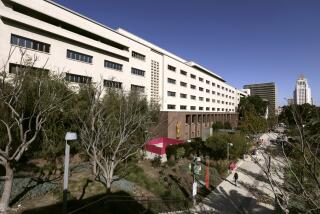Decision ’94 / SPECIAL GUIDE TO CALIFORNIA’S ELECTIONS : Propositions : 190: Overhaul of Judges’ Discipline Panel : WHAT IT IS
Proposition 190 would radically restructure the state Commission on Judicial Performance, the agency charged with disciplining wayward judges.
Currently, the San Francisco-based panel is made up of nine members: five judges, two lawyers and two members of the public. It operates in the strictest secrecy. It is authorized to admonish judges privately or recommend to the state Supreme Court that a judge be censured or removed from office.
Proposition 190 would amend the state Constitution to increase the membership of the commission to 11--six members of the public, two lawyers and three judges. The change would give the public, not judges, a majority on the panel. The measure would require all proceedings to be open after formal accusations are made against a judge. It would give the commission the authority to remove a judge on its own.
ARGUMENTS FOR
The panel has been overly secretive and ineffective, and wholesale institutional reform is necessary. Numbers tell the story. Although the number of complaints against judges soared from 260 in 1980 to 950 in 1993, the number of cases in which disciplinary action was taken increased only from nine in 1980 to 16 in 1993.
Until it recommended in September that San Diego Superior Court Judge G. Dennis Adams be removed from office, the commission had not voted to publicly censure or remove a judge for six years.
Because the majority of commission members are judges and because a judges’ association writes the commission’s rules, “these arrangements help to guarantee that the commission will be the sleeping watchdog it has been,” said Stephen Barnett, a law professor at UC Berkeley.
An 11-member panel dominated not by judges but by the public would assure “an end to this whole system of secret litigation that judges have set up,” said Peter Keane, a San Francisco defense lawyer and member of the board of governors of the State Bar of California who helped draft the initiative.
In addition, by opening proceedings to the public after a judge has been formally charged with wrongdoing, Proposition 190 would enable the public to assess for itself the process of judging the “few bad apples” in the judiciary.
Erwin Chemerinsky, a law professor at USC, argues: “The way (the commission) is set up now, if nothing else it creates the appearance that judges--acting in secret--will protect other judges.
“By exposing (the commission) to public scrutiny and having a commission independent of the judiciary, we will create the appearance as well as the reality, hopefully, of a much better system for investigating and disciplining judges.”
ARGUMENTS AGAINST
The momentum for reform is understandable. But Proposition 190 is bad medicine. Instead of an 11-member commission, the California Judges Assn. calls for a 12-member commission divided equally among lawyers, judges and the public--four each. In August, the American Bar Assn. endorsed such a plan. On an 11-member panel, a majority of eight--all eight appointed by politicians, not by judges--could gang up on the minority of three judges. In addition, judges point out that Proposition 190 is flawed because it would give an 11-member commission the power to write its own rules and decide who and how, under those rules, to prosecute, judge and punish.
In the courts, the functions of prosecutor and judge are separate, and if Proposition 190 passes, a lawsuit challenging it on such constitutional grounds is all but certain.
WHO SUPPORTS IT
Several newspaper editorial boards; Assembly Speaker Willie Brown (D-San Francisco); San Diego Superior Court Judge Terry B. O’Rourke.
WHO OPPOSES IT
California Judges Assn.; retired Los Angeles Superior Court Judge Joseph A. Wapner of “People’s Court” television fame; Arleigh Woods, justice, 2nd District Court of Appeal; state Sen. Quentin Kopp (I-San Francisco); state Assemblyman Ray Haynes (R-Murrieta).
More to Read
Get the L.A. Times Politics newsletter
Deeply reported insights into legislation, politics and policy from Sacramento, Washington and beyond. In your inbox three times per week.
You may occasionally receive promotional content from the Los Angeles Times.










